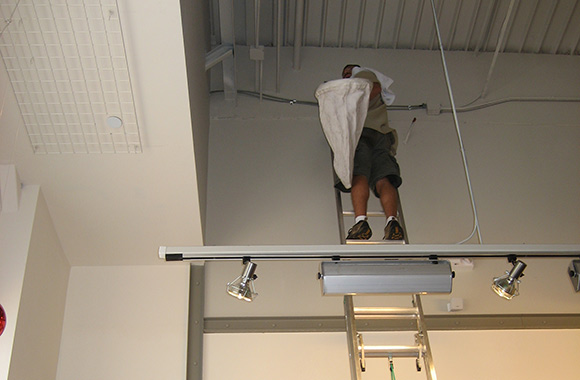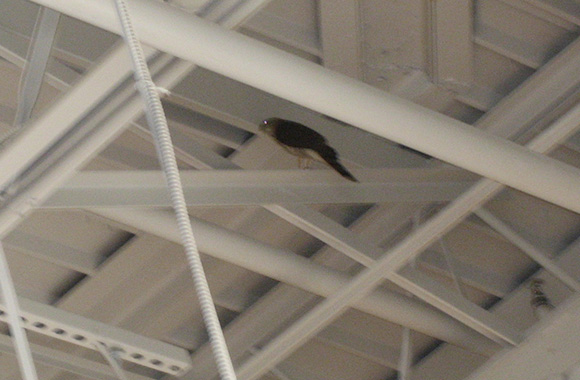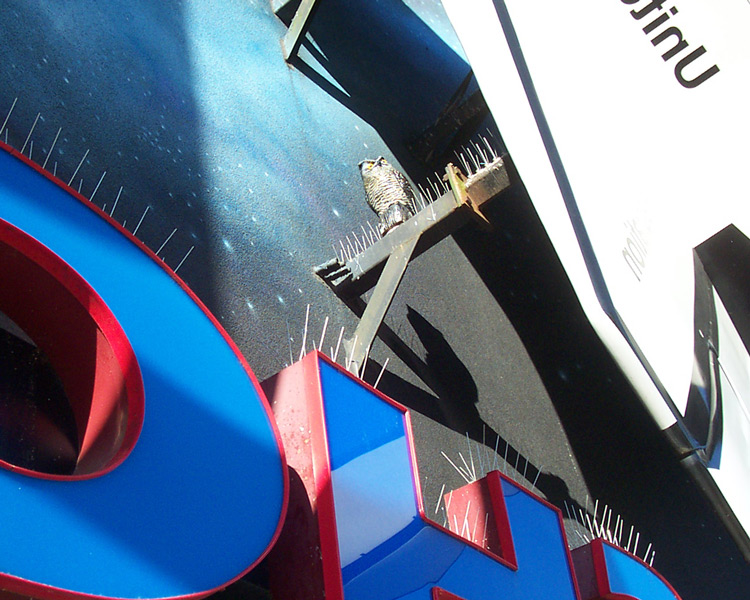Removal of birds in a building, large store or warehouse
Birds in commercial buildings and health risks they carry are a serious issue that requires swift and thoughtful reaction. Birds can be a nuisance for numerous reasons. For the majority of people, the amount of feces that birds dump in places they roost is a serious problem. First, bird feces is a serious health threat to anyone who comes in contact with it or inhales it. Birds carry large numbers of bacteria and viruses, which can cause serious infections. These infections can cause exterior symptoms like rash, blistering, redness, as well as headaches, nausea, diarrhea and vomiting. More serious infections include internal organ failure and sometimes permanent neurological damage. In addition to that, birds can pollute drinking water and food if they are roosting stores, storages and warehouses that store these items. For more than one reason, it is important to find a right way to remove birds from these areas. Unlike other spaces, stores and warehouses are hard to protect against birds due to their size. Additionally, these spaces usually require wide and spacious vents in order to keep the air circulating, which provide an easy access to birds.


Obstacles to removing birds from spaces like warehouses and storages lie in the limitation this spaces have for using some of the more common removal methods. These spaces are usually too large to net entirely, and bird spikes can usually be installed only in limited areas. These spaces require a carefully thought-out use of multiple bird deterrent in order for the process to be successful. Depending on the particular are birds roost in, different deterring methods are needed. An additional obstacle to handling birds in stores and warehouses is the legal one. It is possible that birds roosting in these spaces are forbidden from being killed or disturbed during the particular months of the year. Luckily, deterrents like fogging, bird spikes and netting will keep the birds away without harming them. The good news is that there are plenty of ways to secure these areas against birds in a humane way.
Fogging is one of the methods used to deter birds away without inflicting any harm on them. Essentially, fogging is the process during witch an organic, chemical deterrent is released from a fogging machine. The chemical itself is harmless to birds, and is not going to damage their health in any way. The deterrent, when spread all over the surface, is overwhelming to the bird’s sense of smell. Birds are not able to take the smell, which means that they will stop roosting in the area. Fogging is a process which is best done by professional services, although it is possible to do it on your own properly. If an untrained person handles the fogging machine, there is a risk of injury and inhaling of the strong chemical, which could lead to health problems. While fogging is usually a good solution for spacious buildings with high ceilings, it is not recommended to use it in spaces that people inhabit.
Bird spikes are another type of a bird deterrent that is supposed to keep the annoying tweeters away without harming them. Long and pointy spikes lodged into a sturdy base don’t allow the bird to land onto the surface. Hence, the bird is no longer able to roost in that area. Similar to fogging, bird spikes are a humane way to keeping the birds away. They will not harm them in any way or cause any pain. The advantage of this method is that in can be used in spaces that are hard to reach or apply other deterrents in. however, a downside to using spikes is that usually bird feces and up piling between spikes in large amounts. This leaves the owners with two choices. They can either change the spikes frequently, or clean the ones that got soiled regularly. Similar to fogging, the process of applying bird spikes is best done by licensed professionals.
Bird netting is a very©©© well- known way of deterring birds. Nets are also tools that will be effective for the largest number of bird species, and they are flexible enough to apply in different areas. In buildings such as stores and warehouses, bird nets are used to cover chimneys, vents and windows. Vents are the most frequent entry spots in these buildings due to their size. They are also not possible to completely seal, because it would compromise the air inside the buildings. Bird nets are very easy to install and most often don’t require any expert help. However, if they are in which the net is needed is hard to reach or cover, it is better to have an expert’s help to make the net effective. Bird nets are also a good deterrent to many species of critters and rodents that seek shelter in commercial buildings.
Before you begin with the installation of any of these tools, make sure to check all the legal points of removing birds in your area, as well as to protect your own health with carrying adequate protective equipment while handling birds.

The building, structure or space you are trying to protect from nuisance birds will play a big role in choosing the right approach to take. There is no one-size-fits-all answer for the removal of birds, but there are lots of different approaches that you can combine for best results. Each of these approaches will bring different results.
Warehouses and large stores, for example, are often best protected using bird netting, which, when installed, stops pigeons from being able to roost or land on the pillars or other structures in the higher areas.
Buildings, particularly high ones, often have bird problems along window ledges and other flat surfaces. Properly installed bird spike strips can help put an end. Both the spike strips and the netting are designed to prevent the bird from being able to land in its usual spot, forcing it to find somewhere else instead. Dummies and decoys designed to mimic predators can also work to ‘scare' the nuisance birds away, and noise or light devices can also be effective.
These approaches are all temporary. As soon as you remove the netting, spike strips, repellent, dummies, or light/sound devices, the nuisance birds can and likely will return. The best approach you can take is to combine these methods with another one: proper sealing of the building. Remove bird entry points as much as you can, eliminating the threat of not just nuisance birds, but also other nuisance wildlife.
What should I do if a bird gets inside my apartment block?
It can be very easy to ignore a wild bird that’s flown into an apartment block, especially one where there are so many other people living in the same building. This isn’t a problem that you should pass on to someone else without resolving it, however. Bird feces is notoriously dangerous, spreading potentially deadly diseases. It is also unsightly, smells, and acts as a corrosive material. A buildup of bird droppings, if left, could corrode through walls, floors, ceilings, and more.
One of the easiest things you can do when a bird has flown into an apartment block and can’t get out, is to open the doors and hope that the bird flies out of its own accord. Unless you can convey a message to every apartment on every floor of that block, it is not always recommended to open all of the windows and leave them open. This is especially the case if the block contains families with young children, or pets.
If the bird doesn’t want to fly out of the building, or can’t seem to find a way to, call the person or company that is in charge of your building. Speak to your landlord, or a property manager, or the rental company. If you own the building, that person is you.
The property manager will often call a wildlife removal officer or company to come and remove the bird safely and humanely. The property manager might even choose to do the job him or herself. Either way, the bird will need to be physically removed from the building.

